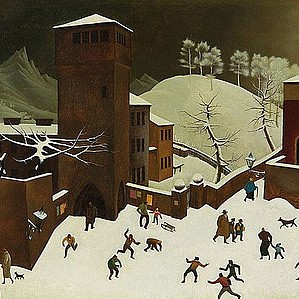WILHELM JARUSKA (Vienna 1916 - 2008 Vienna) Farmhouse in Carinthia
Lot 204
Categories
Estimate:
EUR€1,500 - EUR€2,000
$1,562.50 - $2,083.33
Absentee vs Live bid
Two ways to bid:
- Leave a max absentee bid and the platform will bid on your behalf up to your maximum bid during the live auction.
- Bid live during the auction and your bids will be submitted real-time to the auctioneer.
Bid Increments
| Price | Bid Increment |
|---|---|
| EUR€0 | EUR€10 |
| EUR€100 | EUR€50 |
| EUR€700 | EUR€100 |
| EUR€1,000 | EUR€200 |
| EUR€3,000 | EUR€300 |
| EUR€3,600 | EUR€400 |
| EUR€4,000 | EUR€500 |
| EUR€7,000 | EUR€1,000 |
| EUR€16,000 | EUR€2,000 |
| EUR€30,000 | EUR€3,000 |
| EUR€36,000 | EUR€4,000 |
| EUR€40,000 | EUR€5,000 |
About Auction
By Widder Auctions
May 19, 2022
Set Reminder
2022-05-19 11:00:00
2022-05-19 11:00:00
America/New_York
Bidsquare
Bidsquare : Masterpieces
https://www.bidsquare.com/auctions/widder-auctions/masterpieces-9287
Masterpieces of classical modernism by Austrian and international artists coming up for auction in Vienna on May 19th Widder Auctions office@widderauktionen.com
Masterpieces of classical modernism by Austrian and international artists coming up for auction in Vienna on May 19th Widder Auctions office@widderauktionen.com
- Lot Description
WILHELM JARUSKA*
(Vienna 1916 - 2008 Vienna)
Farmhouse in Carinthia
mixed media/paper, 33,8 x 49,5 cm
inscribed In Kärnten
depicted in Wilhelm Jaruska, Vienna 2020, p. 32, N. 84
Provenance: estate of the artist, private collection Vienna
ESTIMATE °€ 1.500 - 2.000
Austrian painter, art educator and graphic artist of the 20th century. Representative of modernism after 1950 and representational painting. Studied at the Kunstgewerbeschule with Wilhelm Müller-Hofmann together with Arthur Zelger, Rudolf Korunka and Paul Kurt Schwarz. After World War II, very successful as a poster artist and commercial artist. From 1954 to 1976 he taught poster art and illustration at the Graphische Lehr- und Versuchsanstalt, his students included Manfred Deix and Gottfried Helnwein. Involvement with Austrian Expressionism by Egon Schiele, Oskar Kokoschka and Herbert Boeckl. Created in addition to portraits and figure paintings also landscapes from the forest and Mühlviertel but also of vacations and summer resorts in Carinthia.
After promising beginnings in the 1930s, the Viennese painter, graphic artist, book illustrator, poster artist, designer and educator Wilhelm Jaruska was only able to succeed as a painter again in the 1950s due to the confusion of the times. It was above all the precarious conditions between and after the two world wars, the gruelling war service and bread work in the first post-war years that made it almost impossible for Jaruska to develop freely as a painter. Jaruska's educational path led via the School of Applied Arts in Vienna and studies with Albert Paris Gütersloh at the Academy of Fine Arts to the Höhere Graphische Bundeslehr- und Versuchsanstalt in Vienna, where he worked as a professor. As a graphic artist, designer and painter, he was responsible not only for a series of posters, murals and children's book illustrations, but also for mosaics and concrete glass windows. His multi-faceted oeuvre spans a period from the 1930s to the recent past. Above all, his great mastery consisted in the fact that – regardless of which technique, stylistic basic trend or compositional structure he turned to in the individual creative periods – he always used the picturesque, which he knew how to distill from every seemingly trivial, everyday situation, into an effective one -Knew how to transpose in a striking way or into the harmoniously poetic. As a commercial artist, he was so familiar with all stylistic languages that he was able to deal with them very freely. Wilhelm Jaruska very much coloured his works on paper, which he began en plein air with pencil or biros, only afterwards, often years later, at home. Why the artist did not finish colouring this Carinthian farmhouse is not known. However, this unusual state of suspension between small-scale pencil drawing and brightly coloured gouache lends the picture a very special charm. The coloured farm emerges from the surrounding black and white like a dear memory. With almost tender devotion, Jaruska has coloured the smallest details - door, window frame and flowers - and thus clearly accentuated them, while leaving the house next door and the alley in fine grey tone.
PLEASE NOTE:
The purchase price consists of the highest bid plus the buyer's premium, sales tax and, if applicable, the fee of artists resale rights. In the case of normal taxation (marked ° in the catalog), a premium of 24% is added to the highest bid. The mandatory sales tax of 13% is added to the sum of the highest bid and the buyer's premium. The buyer's premium amounts to 28% in case of differential taxation. The sales tax is included in the differential taxation. - Shipping Info
-
Shipping
We will send you the invoice shortly after the auction. As soon as we have recieved the amount, the art can be picked up at Johannesgasse 9-13, 1010 Vienna. Please note that the buyer is responsible for pick-up and shipping of the lot.
Should you wish to ship your items, please contact: Mailboxes Email: oper@mbe-co.at Tel: 01 5128855
Please note that storage fees may apply, should the pieces not be picked up within 14 days after invoicing for domestic and 28 days for international transportation.
Our team will be happy to assist you with any further information at office@widderauktionen.com or at 0043 676 555 66 10.
-
- Buyer's Premium



 EUR
EUR CAD
CAD AUD
AUD GBP
GBP MXN
MXN HKD
HKD CNY
CNY MYR
MYR SEK
SEK SGD
SGD CHF
CHF THB
THB












